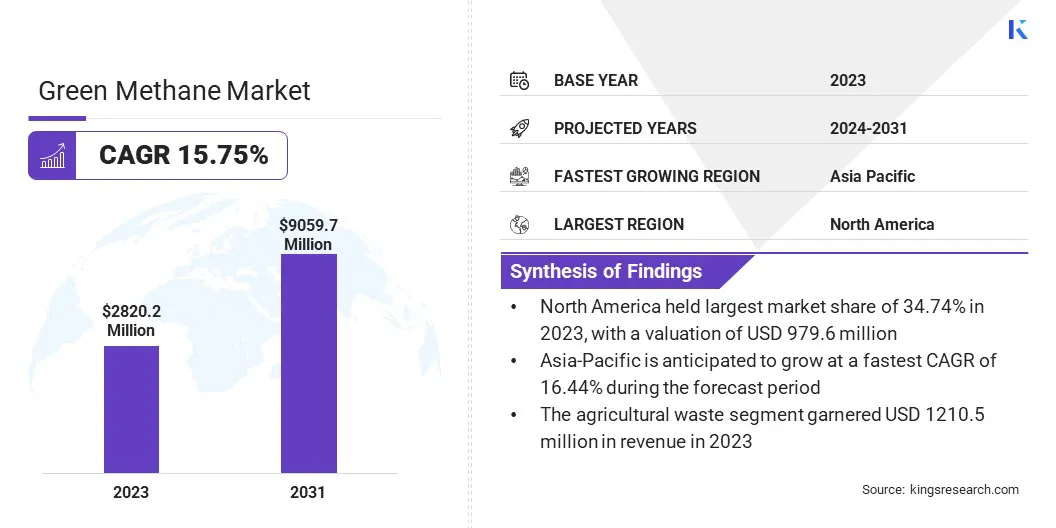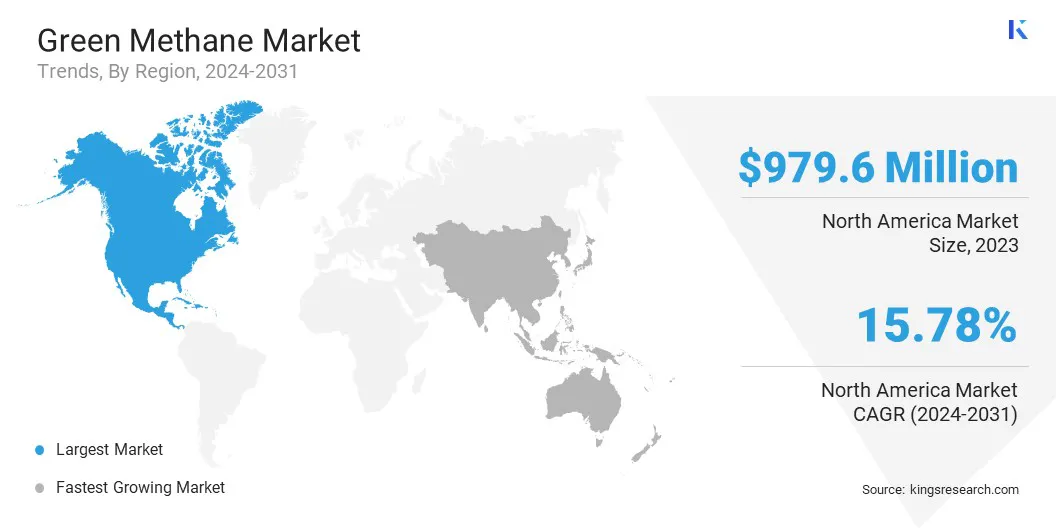Market Definition
The green methane market encompasses the production, distribution, and use of methane derived from sustainable sources, such as agricultural waste, food scraps, and wastewater.
Unlike fossil-based natural gas, green methane is typically produced through anaerobic digestion to generate bio methane, which is then upgraded to meet natural gas standards. This market includes the production, storage, and transportation of green methane, as well as its applications in power generation, heating, and transportation.
Green Methane Market Overview
The global green methane market size was valued at USD 2820.2 million in 2023 and is projected to grow from USD 3253.9 million in 2024 to USD 9059.7 million by 2031, exhibiting a CAGR of 15.75% during the forecast period.
Market growth is driven by the increasing demand for sustainable energy solutions, rising environmental concerns, and the implementation of stringent government regulations aimed at reducing carbon emissions.
Green methane, produced from organic waste and biomass, presents a cleaner alternative to conventional natural gas, supporting decarbonization efforts across various industries.
Major companies operating in the global green methane industry are EnviTec Biogas AG, Future Biogas Ltd, Weltec Biopower GmbH, AB HOLDING SPA, Ameresco, Renergon International AG, PlanET Biogas Group, OCI, Carbon Recycling International, Clean Energy Fuels, BP p.l.c., Verbio SE, Vanguard Renewables., J V Energen LLP, and Gasrec.
The market is further bolstered by advancements in biogas production technologies, methane upgrading processes, and storage solutions, along with growing investments in renewable gas infrastructure.
As the global energy transition progresses and nations strive for net-zero emissions targets, green methane is poised to play a pivotal role in meeting energy demands while mitigating environmental impacts.
- In July 2024, PlanET Biogas USA Inc. achieved a record 12 plant completions within a 12-month period across the United States. All projects utilize PlanET’s advanced Anaerobic Digestion (AD) technology, with 10 also featuring PlanET STATERON RNG Upgrading Technology.

Key Highlights
- The global green methane market size was valued at USD 2820.2 million in 2023.
- The market is projected to grow at a CAGR of 15.75% from 2024 to 2031.
- North America held a share of 34.74% in 2023, valued at USD 979.6 million.
- The agricultural waste segment garnered USD 1210.5 million in revenue in 2023.
- The combined heat & power production segment is expected to reach USD 3478.9 million by 2031.
- Asia Pacific is anticipated to grow at a CAGR of 16.44% over the forecast period.
How are Energy Transition and Decarbonization driving the market?
Energy transition and decarbonization boost the growth of the green methane market as nations reduce fossil fuel dependence and achieve low-carbon energy systems. Green methane, produced from renewable sources such as organic waste and biomass, offers a sustainable alternative to natural gas.
Unlike intermittent renewables, it can be stored and transported, providing reliable energy and enhancing grid stability. Green methane, sourced from waste, can be carbon-neutral or carbon-negative, supporting net-zero targets.
Its compatibility with existing natural gas infrastructure facilitates a cost-effective transition, while its use in hard-to-electrify sectors such as heavy industry and transportation advances decarbonization efforts.
- In April 2024, IHI Corporation developed innovative technology for producing green methane through its advanced processes, contributing to global decarbonization efforts. The process converts renewable energy into hydrogen and utilizes carbon dioxide to produce synthetic methane, offering a sustainable solution to reduce carbon emissions across industries, including energy and transportation.
What are the negative implications of high production cost?
A major challenge hampering the growth of the green methane market is its high production costs. Producing green methane from organic waste or biomass requires advanced technologies such as anaerobic digestion and methane upgrading, demanding significant capital investment and resulting in higher operational costs than conventional natural gas. Without substantial government incentives or subsidies, green methane remains less competitive, limiting its broader adoption.
Technological advancements in anaerobic digestion and methane upgrading improve efficiency and reduce energy consumption, lowering costs. Economies of scale from centralized production facilities further drive cost reductions.
Optimizing feedstock management and sourcing cost-effective raw materials further contribute to affordability. Government incentives play a crucial role in market development, while cross-sector collaboration across agriculture, waste management, and energy enhances supply chain efficiency and reduces logistical expenses.
How are investments shaping the market?
Governments are offering financial incentives, subsidies, and favorable policies to promote renewable gas technologies, while the private sector is increasingly investing in green methane for its decarbonization potential in hard-to-electrify sectors.
Major energy firms and startups are investing in research and development to improve production processes, reduce costs, and enhance scalability. Partnerships between agriculture, waste management, and energy sectors are fostering innovation and supply chain efficiency.
These efforts are accelerating technological advancements, making green methane a more cost-effective and competitive energy source, aligning with global sustainability and climate goals.
- In November 2024, MIT spinout Emvolon introduced a novel approach to methane processing by repurposing automotive engines into modular, cost-effective plants for greener chemical production. By capturing emissions from internal combustion engines, the company’s technology converts carbon dioxide into valuable fuels and chemicals, thereby reducing greenhouse gas emissions while supporting the transition to sustainable energy sources.
Green Methane Market Report Snapshot
|
Segmentation
|
Details
|
|
By Type
|
Agricultural Waste, Municipal Landfill, Others
|
|
By Application
|
Combined Heat & Power Production, Transport, Others
|
|
By Region
|
North America: U.S., Canada, Mexico
|
|
Europe: France, U.K., Spain, Germany, Italy, Russia, Rest of Europe
|
|
Asia-Pacific: China, Japan, India, Australia, ASEAN, South Korea, Rest of Asia-Pacific
|
|
Middle East & Africa: Turkey, UAE, Saudi Arabia, South Africa, Rest of Middle East & Africa
|
|
South America: Brazil, Argentina, Rest of South America
|
Market Segmentation
- By Type (Agricultural Waste, Municipal Landfill, and Others): The agricultural waste segment earned USD 1210.5 million in 2023 due to the increasing use of organic residues for biogas production and renewable energy generation.
- By Application (Combined Heat & Power Production, Transport, and Others): The combined heat & power production held a share of 38.38% in 2023, fueled by its efficient utilization of green methane for both electricity generation and heat supply in industrial and residential applications.
What is the market scenario in North America and Asia-Pacific region?
Based on region, the global market has been classified into North America, Europe, Asia Pacific, Middle East & Africa, and Latin America.

North America green methane market captured a notable share of around 34.74% in 2023, valued at USD 979.6 million. This growth is attributed to the region's robust commitment to renewable energy adoption, supportive government policies, and advanced technological infrastructure facilitating green methane production.
The presence of key industry players, coupled with increasing investments in sustainable energy solutions and biogas projects, further strengthen regional market position. Moreover, the growing demand for renewable natural gas (RNG) across sectors such as transportation and industrial heating is accelerating the adoption of green methane technologies.
- In May 2023, TotalEnergies partnered with Ductor to develop and invest in several biomethane production projects across the U.S. and Europe. Ductor currently has a pipeline of 15-20 projects, including several at advanced stage.
Asia Pacific green methane industry is likely to grow at a robust CAGR of 16.44% over the forecast period, supported by government initiatives aimed at promoting renewable energy and reducing carbon emissions.
Notably, countries such as China and India are making significant investments in biogas infrastructure and sustainable fuel technologies to address energy security and environmental challenges.
The increasing demand for clean energy solutions in the agricultural and industrial sectors, combined with the abundant availability of organic waste, is expected to foster the adoption of green methane.Supportive policies and financial incentives further position Asia Pacific as a key market for green methane.
Regulatory Frameworks
- The National Green Hydrogen Mission seeks to reduce carbon emissions, promote energy security, and support India's transition to a low-carbon economy by scaling up green hydrogen production and integrating it into key industries.
- The Renewable Energy Directive Recast (RED II) accelerates the EU's renewable energy transition by mandating a minimum of 32% renewable energy in the overall energy mix by 2030.
- The Renewable Fuel Standard (RFS), managed by the U.S. Environmental Protection Agency (EPA), mandates the blending of renewable fuels into the transportation sector. It aims to reduce emissions, expand the renewable fuel market, and reduce reliance on imported oil through annual biofuel blending targets.
- The European Union (EU) Fuel Quality Directive seeks to reduce the greenhouse gas intensity of transport fuels by promoting cleaner alternatives such as green methane and biofuels, aligning with the EU's climate and energy objectives.
Competitive Landscape
The global green methane market is characterized by a number of participants, including both established corporations and emerging players. Prominent energy companies are broadening their portfolios to incorporate renewable gases, with green methane production emerging as a key sustainability focus.
Concurrently, startups and specialized firms are advancing biogas technologies, methane upgrading, and feedstock optimization. Market participants actively engage in partnerships, joint ventures, and strategic alliances to enhance technological capabilities, improve production efficiency, and strengthen the value chain.
As the market matures, competition intensifies, fostering a focus on cost-effective solutions, scalability, and adherence to sustainability standards. This dynamic landscape fosters investment and technological progress, solidifying green methane's role in the global energy transition.
- In June 2023, TotalEnergies signed a 100 GWh biomethane purchase agreement with Saint-Gobain France for a three-year period starting in 2024. This aligns with the company’s carbon reduction strategy and France’s climate goals
List of Key Companies in Green Methane Market:
- EnviTec Biogas AG
- Future Biogas Ltd
- Weltec Biopower GmbH
- AB HOLDING SPA
- Ameresco
- Renergon International AG
- PlanET Biogas Group
- OCI
- Carbon Recycling International
- Clean Energy Fuels
- BP p.l.c.
- Verbio SE
- Vanguard Renewables.
- J V Energen LLP
- Gasrec
Recent Developments (M&A/Partnerships/Agreements/New Product Launch)
- In August 2024, Prince Michel Vineyard & Winery partnered with Vanguard Renewables to convert organic waste into renewable energy through a farm-based anaerobic digester. This initiative reduces the winery's carbon footprint, contribute to sustainability efforts, and produces renewable natural gas for environmental benefits.
- In July 2023, BP expanded its bioenergy investment by collaborating with WasteFuel to accelerate the production of sustainable biofuels, including green methane. This collaboration aims to scale the production of renewable natural gas (RNG) from organic waste as a cleaner alternative to fossil fuels in transportation.


